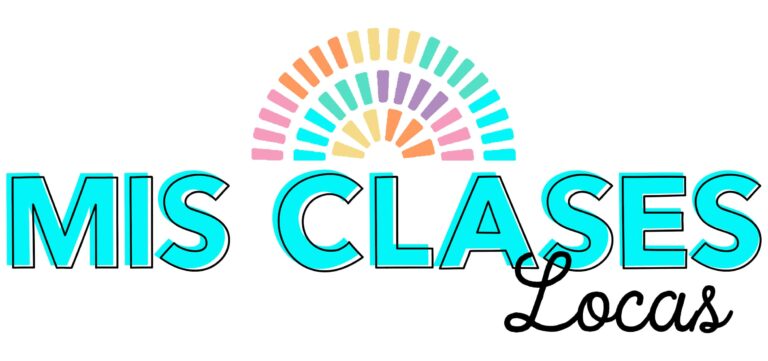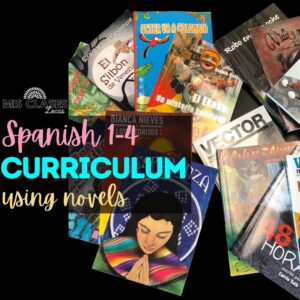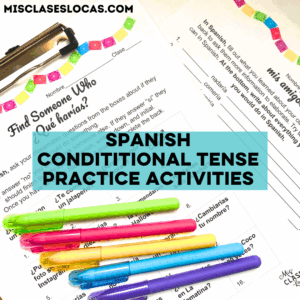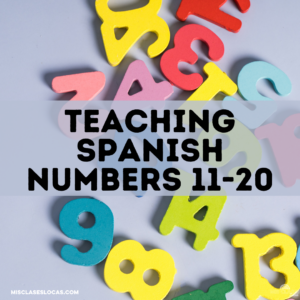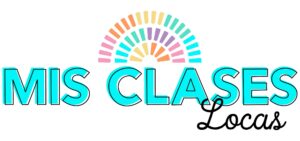Inside: How to teach multiples levels of Spanish at the same time. Teaching different levels of Spanish proficiency, different levels of Spanish fluency & different levels of Spanish class at the same time. Sustainable Spanish plan for multi level Spanish classes.
Author – Allison Wienhold
Published – January 6, 2025

Teaching Multilevel Spanish Classes – Strategies and Success
Teaching a multilevel Spanish class can feel like juggling 100 tasks at once. But, with the right strategies, it’s entirely possible to engage students at different levels of Spanish proficiency effectively. Whether you’re navigating the challenge of teaching multiple levels in one classroom or supporting students with varying levels of Spanish fluency, this blog will guide you with practical tips and plans for success.
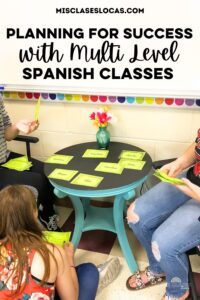
Understanding the Levels of Spanish Proficiency
Before crafting a plan for a multilevel classroom, it’s important to recognize what are the levels of Spanish proficiency. Commonly, Spanish learners are categorized using the ACTFL guidelines. They provide a framework for evaluating language ability. Each proficiency level is divided into sub levels that describe what learners can do with the language in real-life contexts.
Feel free to skip this section if you are a proficiency level ninja. Help you & your students get a better understanding of proficiency levels with the Proficiency Puzzle.

Novice Level
The Novice level is for beginning learners and is divided into three sub levels: Novice Low, Novice Mid, and Novice High.
- Novice Low
- What They Can Do: Learners at this level produce isolated words or memorized phrases. Communication is limited to responding to basic prompts.
- Focus in Class: Vocabulary building, basic pronunciation, and repeating model sentences.
- Novice Mid
- What They Can Do: Learners can produce simple phrases and lists but often struggle to form complete sentences. They rely on memorized expressions.
- Focus in Class: Expanding phrases, introducing sentence patterns, and practicing survival language (e.g., “Where is the bathroom?”).
- Novice High
- What They Can Do: Learners begin to create with language in a limited way. They can ask and answer basic questions, but errors are frequent.
- Focus in Class: Encouraging sentence-level responses, practicing common questions, and increasing confidence in speaking.
Intermediate Level
The Intermediate level focuses on improving communication skills and is divided into Intermediate Low, Intermediate Mid, and Intermediate High.
- Intermediate Low
- What They Can Do: Learners communicate in basic sentences and can handle simple social interactions. They understand and respond to familiar topics but often need repetition.
- Focus in Class: Developing sentence variety, introducing connectors (and, with, because, with), and increasing speaking fluency.
- Intermediate Mid
- What They Can Do: Learners can handle routine conversations about familiar topics. They begin using strings of sentences and can express personal meaning.
- Focus in Class: Expanding vocabulary for diverse topics, refining grammar (e.g., past tense), and working on coherence in responses.
- Intermediate High
- What They Can Do:
Learners speak with ease on familiar topics and attempt more complex conversations. Errors occur in complex tasks, but they maintain communication. - Focus in Class: Practicing advanced grammar, improving accuracy, and using transitional phrases to connect ideas.
- What They Can Do:
Advanced Level
The Advanced level highlights fluency and the ability to handle more complex language tasks. It includes Advanced Low, Advanced Mid, and Advanced High. Your middle/high school students will likely only reach advanced levels if they are Heritage or Native speakers, have spent significant time around the language or have had more than the standard Spanish 1-4 in high school. So I’m only including Advanced Low here.
- Advanced Low
- What They Can Do: Learners express themselves clearly in conversations, although pauses may occur when attempting complex ideas. They can handle unexpected situations.
- Focus in Class: Improving spontaneity, reducing reliance on rehearsed phrases, and introducing nuanced language.
Tips for Supporting Each Level
By recognizing the abilities and needs of each subgroup, you can create a tailored, engaging environment where all students thrive. To support diverse proficiency levels in your class:
- Novice Learners: Beginning learners with limited vocabulary and understanding. Focus on repetition, visuals, and hands-on activities.
- Intermediate Learners: Students can create sentences and engage in simple conversations. Provide opportunities for conversation and structured output.
- Advanced Learners: Learners communicate more fluidly, with greater accuracy and complexity. Encourage detailed responses, creativity, and immersion.
Identifying the different levels of Spanish proficiency in your class helps you create a multilevel curriculum tailored to student needs.
Challenges of Multilevel Spanish Classrooms
Multilevel Spanish classrooms often include students across multiple grades, levels and fluency levels. Teachers may wonder, how do I teach multiple levels in one class? or How can I plan for teaching multiple grades in one classroom? These challenges require careful planning and innovative teaching approaches.
During the 2020-2021 school year I was assigned to teach Spanish 3 and Spanish 4 during the same block period. You can see more specifics about that situation in the blog posts – Block Schedule & Hybrid Teaching.
I know with budget cuts and shrinking language programs, many World Language teachers are now expected to teach not just multiple proficiency levels (which has always been the case), but now multiple grades and preps simultaneously. It is also common to have Heritage speakers of a variety of abilities placed into a novice Spanish 1 class.
Teaching Approaches for Multigrade and Multilevel Spanish Classes
Here are some effective strategies for teaching multilevel Spanish classes.

Group by Proficiency – Divide students into smaller groups based on their Spanish proficiency levels.
Say you are teaching a mixed 6th-8th grade exploratory middle school class. It’s possible that these students have had various amounts of Spanish instruction, with a mix of Heritage Spanish students as well. Meet students where they are & build from there!
It’s OK to have a novice group & intermediate group with different expectations of output. These groups may be learning about the same topic, but with different resources and expectations. For example when doing a post break Find Someone Who using the preterite tense using my 1st Day Back from Winter Break Plans.
- Novice Group – If this is a true novice group who is new to the preterite have them use this Fue Find Someone Who with only one verb in the past tense. If they know more verbs you can use the same resource below with scaffolding & using the version with the yo form provided. They also use the sentence starters to write about what their friends did in the past tense. Or even within this group you can give students the option if they want the form with more support or not! Let students who are ready to push themselves push their proficiency level forward.
- Intermediate+ Group – Uses the more advanced 1st Day Back from Winter Break Preterite Find Someone Who with multiple verbs. Students can use the version without scaffolding and then do a more open ended free write in the preterite about their friends in organized paragraph form.
Read the post mixing up Find Someone Who for more ideas or watch the video below for a specific example of differentiation the Post Break Find Someone Who.
Leverage Differentiated Instruction – Same Topic – Different Tasks
Differentiated instruction ensures all students are challenged appropriately. Read more in my in-depth post Differentiation in Spanish Class.

From my experience, I have found that it is much easier if the whole class, regardless of level is doing the same unit at the same time. When I taught my combined Spanish 3/4 class it was WAY easier to keep my sanity if we were all doing the same unit together. We just had varying expectations of output and support as needed.
One way to use differentiated planning is to use the same theme or topic but vary the complexity.
- Example Topic You are required to cover – Food and Restaurants
- Novice: Learn food vocabulary and simple phrases.
- Intermediate: Practice ordering food and role-playing a restaurant scenario.
- Advanced: Discuss cultural dining customs or write a detailed restaurant review in Spanish.
The tricky part here are the Logistics of how to have multiple different tasks happening simultaneously. It takes a lot of planning. One strategy is to have independent work set up for the other half. This could rotate every other day as needed as well. For example
- First half of class – Level 4 gets direct instruction/support from the teacher. Level 3 does independent work/practice assigned on Google Classroom.
- Second half of class – Level 3 gets direct instruction/support from teacher. Level 4 does independent work/practice assigned on Google Classroom.
Same Unit – Different Groups
Beyond the temporary flexible groups you could group students for an entire unit. One way to differentiate instruction is by grouping students according to their level of knowledge or understanding. You could group them based on language proficiency or the support needed.
This allows different activities for each group while still teaching the same material. Additionally, it allows students with similar skill levels to learn from each other and build confidence in their abilities as they collaborate. Below are two in-depth blog posts which show how to read novels in different groups.
Spanish 1 Reading Club – 1 Novel, 3 Differentiated Groups
This is great way to support multiple levels of classes and proficiency levels, while keeping sanity of only teaching one book at a time. I had students grouped so I could best support the group that needed it the most with more time.
Upper-Level Spanish Literature Circles
I have been using this type of Lit Circle with a few different novels at the same time in groups for years.
I did a version of this with my multilevel class with Spanish 4 reading La Calaca Alegre while Spanish 3 reading Robo en la Noche. The problem was that I should have chosen easier novels for them to have more independence. SIince this was after the 2020 lockdown, these classes were about a level lower than typical, so the novels felt very cumbersome for them at the time without me there 100%. Lesson learned – pick easier novels to build confidence, especially if multiple are being read simultaneously.
Rotating Curriculum
I know that teachers who regularly teach multilevel classes such as a combined level 3 & level 4 have a 2 year rotating curriculum. Year 1 both levels get the units in the year 1 path. Then year 2 both levels get the 2nd set of units. Then the next year the rotation starts over. The Huellas Curriculum from Carrie Toth is perfect for this type of set up. The thematic units can be done in many orders and do not have to be sequentially in order.
Same Routines for all Students
A great way to give yourself breathing room at the start of class to be able to support multiple levels or grades at once are classroom routines. Have the same daily bell ringers for everyone. This gives you a chance to check in with specific students & handle admin tasks while other students have a task to complete. I have a full set of routines for every day of the school year if you are interested. Plus I have a new Younger set of a year of routines if you teach Middle School or Upper Elementary.
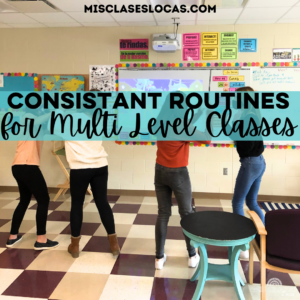
Or you can get a sample week of my classroom routines below to help support your multilevel Spanish class.
Create Flexible Lesson Plans
Crafting a plan for multilevel Spanish means building adaptability into your schedule. See Sustainable Spanish Lesson Planning for more ideas of planing for many preps.
One way to do so is to develop a “core lesson” for the whole class, then add extensions or modifications. This keeps everyone learning about the same topic, grammar point, skill or book, which is easier for the teacher to manage.
- Core Lesson: A cultural topic everyone can explore.
- Extensions: Advanced students expand their knowledge with additional in depth study or one of the options below.
Extensions With Technology & Without Tech
Use online resources to teach multiple Spanish proficiency levels. These are great options for independent work while you are teaching new content to other students. Also, these are option to post for “If I’m done, what now.” Have a set list or options posted so you have less interruptions while instructing others.

Extension Ideas for Spanish Class Using Technology
- Google Classroom or similar LMSs are essential for managing a multilevel curriculum & posting what students should be doing while you are wokring with others.
- Duolingo practice
- Roxxem (cloze songs listening practice)
- Choice Flangoo or Garbanzo (paid subscriptions with reading activities)
- Choice Sr. Wooly (paid subscription with song listening activities)
- Study Vocab on Quizlet or individual Blooket Game
- use any of these Websites for Spanish Teachers
- Investigate the country/culture being studied & look for authentic resources
- Ideas from Choice work (but in class, not as homework)
- Websites like Youtube or Edpuzzle with video content provide listening and cultural exposure.
Extension Ideas for Spanish Class – no tech needed
- Free Reading from Spanish classroom library
- Chat in Spanish with a partner – draw & use Question Cards if needed
- Play Verba, Scrabble, or other card or board games in Spanish
- Free Write in Spanish or do a practice Writing activity
- Create something in Spanish – comic, vocab notecards, a bulletin board for class, etc
- Create something related to Spanish culture
- Work towards a larger class goal (Ex. plan to teach Elementary Spanish Lessons)
Looking for Upcoming Virtual Spanish Teacher PD on this Topic?
Make sure to check out Spanish Teacher Professional Development. I will be speaking at The {FREE} World Language Teacher Summit the last week in January & would love to see you there!
>> Get all the info & grab your Free Ticket to couch PD all about sustainable planning for many preps!
Project-Based Learning
Another idea that I have seen other teachers have success with is Project-Based Learning. This is something I tried & used quite a bit at my first school. But, once I moved to more acquisition based instruction, I had a hard time using so much class time to work on projects without a lot of input. But, if you are essentially teaching multiple classes at the same time, work time for the other half is perfect and needed.
You can use project-based learning (PBL) to unite students across levels. For example:
- Project – Create a class travel guide to Spanish-speaking countries.
- Advanced students write detailed sections, and novices state country facts, basic information & design visuals.
Assessments and Grading with Multilevel Spanish Classes
For many years my last school fully embraced Standard Based Grading. This was helpful since the goal was moving up in proficiency levels and to show what you know. Most of my speaking and writing assessments were open-ended with a certain proficiency goal. This gave options for students to show what they learned and understood.
Writing Assessments – A proficiency focus means you can give a writing assessment for all students in the room on the same day. But, the prompt, supports, and output level expected will vary. See this post for more info > Writing in Spanish Class.
Speaking Assessments – Once again you can have everyone do a speaking assessment on the same day as well. There might be different groups of various proficiency levels and topics that are a part of the speaking assessment. Also, Question Cards might be an option to support novice students. Read more Assess Spanish Speaking
Listening & Reading Assessments – The content of input based assessments will likely be different for a multilevel class, especially if you have a wide range of proficiency levels. See Final Assessments for Spanish class & How to Assess a Novel in Spanish class give more information on how I assessed.
Planning for Success in Multilevel Spanish Classrooms

Creating a successful plan for multilevel Spanish involves strategic organization. Here’s how to get started:
Set Clear Goals – Identify specific goals for each level. My syllabus and guardian newsletter also make sure that everyone is on the same page.
Use Sustainable Spanish Lesson Planning – Plan for breaks for the teacher including film units, balance of energy, and use the same units across levels.
Rotate Activities – Use stations for hands-on learning to maximize focused time with the teacher. While one group practices speaking with the teacher, another group does listening with EdPuzzle & another can focus on reading or writing tasks.
Plan for Extensions – Make sure students always know what to do next or independent tasks they can work on without interrupting teaching of another group.
The Joy of Multilevel Teaching
While teaching multiple levels in one classroom may seem daunting, it’s also incredibly rewarding. I had a super high level Spanish 3 student who was able to flourish and be challenged by Spanish 4 students. If he had been in a traditional level 3 class he would not have had nearly the same opportunities to grow in his Spanish proficiency level.
On the flip side, some Spanish 4 students with gaps in their learning were able to feel supported with Spanish 3 peers at a more similar level instead of struggling to keep up with the other Spanish 4 peers. Watching students progress in their language ability reminds us of the beauty of learning languages together.
By leveraging differentiated instruction, technology, and flexible lesson planning, you can confidently teach multiple Spanish proficiency levels. Embrace the creativity and collaboration that a multilevel classroom brings, and your students can thrive.
Have additional ideas or tips for teaching multilevel Spanish classes? Share them in the comments below!

